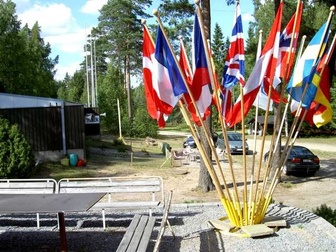Muzzle Loading in the Land of Thousand Lakes

For centuries the castles remained homes for firearms in Finland, which for almost six hundred years was a dominion of Sweden. During the 16th and 17th the production of military firearms developed step by step exclusively under the patronage of frontier strongholds, the guns’ sole purpose then being the protection of the realm against enemies. In the deep forests, however, new inventions gained ground utmost slowly. Unavailability of powder and lead due to long, road less distances was a considerable obstacle, as well as perhaps a stubborn nation’s distrust for everything new. Skirmishes were accomplished with wooden clubs and knives; game was taken with traps, spears and primitive crossbows.
Eventually, sometime around the turn of the18th century, the local country blacksmiths learned to forge primitive gun barrels and make crude snaphaunce-type locks of simple mechanisms thus providing the common people with rough firearms to hunt with.
Later, imported locks from Central Europe were mounted on these more or less homemade looking guns. Back then the rifles used by peasants and hunters were merely described as ”squirrel-small” or ”deer-large”, referring to their caliber and their purpose. In the second half of the century some notorious craftsmen emerged in Finland; gunsmiths who could satisfy even the most exacting demands of a nobleman, wealthy landlord or a rich burgess. Upper classes could and would, of course, purchase their finest hunting weapons from abroad whenever they pleased. Among the common people things changed slowly. The development and availability of firearms was constantly several decades retarded when compared with the advancement elsewhere in Europe. At the turn of the 19th century the cross bow with blunt arrows was still widely used for squirrel hunt. This did not necessarily prove the lack of firearms; it may have been merely a hunting method that prevented damages on the animal’s fur.
Nevertheless, these hunters’ marksmanship was highly marveled by the Italian explorer Giuseppe Acerbi in his journals from Finland in 1799. By that time spear was commonly used for killing bear (a true calamity in those days), when awakening from hibernation in the spring. Well over a century later, old Brown Bess locks, converted to cap locks, were still very serviceable on heavy muzzle loading seal guns.
Restocked flint musket, it’s barrel shortened, worked wonders as fowler, and the big, mortal lead ball bursting from it’s muzzle was still very effective on bear and moose during the 19th century in the deep backwoods of Finland. In 1809 Finland became autonomous Grand duchy of the Russian Empire. The rulers’ political oppression during the last decades of that period caused considerable resistance among the people, which may have led to restrictions regarding possession and availability of modern smokeless firearms in the Grand duchy. Finland gained independency in 1917 and made great strides on every field; this was also the case concerning firearms. The art of muzzleloading, on the other hand, disappeared fast, as did gradually the last muzzle loading generation with their know-how. The come back of muzzle loading.
The renaissance of muzzle loading in Finland dawned in 1978, when Shooting Club Oriveden Ampujat ry. arranged the first shooting competition with ”front stuffers”.
A group of individual arms collectors and weapon enthusiasts had already previously practiced the difficult skills of shooting with muzzleloaders. Awakening interest started to grow here and there, and in 1977 it was time to get organized. The chairman of the mentioned club, Erkki Lähdeniemi, contacted the MLAIC for information, and the Finnish rules and regulations were created following the guidelines of MLAIC rules and constitution. The inauguration took effect in Sept. 15th in 1978, date on which Finland’s membership to the world-organization was approved.
The association representing Finland in the International Committee was now Oriveden Ampujat ry. and the official delegate Erkki Lähdeniemi. Popularity of muzzle loading increased. At the beginning everything was new and things had to be learned the hard way. Practically no literature on the subject in Finnish language was available. Quite a few shooters lost their interest and dropped the hobby disgusted after series of useless attempts to hit the broad side of the barn with their newly acquired guns. To obtain black powder and serviceable muzzle loading firearms was difficult. Frustrated shooters emptied ancient black powder shotgun shells in order to get at least some decent propellant. The original firearms available at a reasonable price were mostly so disregarded; they couldn’t be used for serious shooting. Lack of bullet mold, for instance, brought one inventive shooter to a very ingenious solution: take a board of birch, find a knot in it, then drill a shallow hole in it with a 10 mm drill bit and pour the molten led in the hole! Needless to say, these ”slugs” were not the ideal projectile for an original ball-shooting Lebeda rifle.
Well, though the mysteries of muzzle loading ballistics pretty fast revealed themselves to the owner of this gun, it still took him some time to shoot the standing Finnish record with it! The desire of making good scores obviously haunted one experimental shooter, who was exposed of using ball bearings for musket balls in a competition. Evidently his second thought was to liberate himself of the time consuming task of troublesome bullet-casting operation. Many shooters used to cast their bullets of old wheel weights, an alloy so hard, the ball could only be driven in the barrel by vigorous pounding with a heavy mallet; no wonder that in the early muzzleloading matches in Finland the shooting line reported a hellish noise like it had turned in to a blacksmiths’ workshop! Jammed bullets and broken ramrods were a frequent by-product of this kind of practice. All sorts of patches and greases (incl. sheep tallow and badger fat), bullet lubes and cleaning solutions were constant subjects to keen scientific experiments of persistent home chemists and many sorts of wads and miracle making powder charges were everybody’s headache.
Replicas appear to the market Gunshop
Erkki Lähdeniemi, the main channel for quality muzzle loading firearms in Finland was established in 1983.
Now the new enthusiastic muzzleloaders confronted new obstacles: the issuing authorities of gun licenses got really puzzled up with this new phenomenon. Some regarded black powder arms as harmless toys, whereas others took them for very dangerous military weapons due to their big bore, non-adjustable sights and perhaps a text ”Armi San Marco”. Consequently some applicants were kindly but firmly required to start their shooter’s career ”with something less murderous and more suitable for decent target shooting for beginners, like a .22, smokeless, for example…”
Dedicated trailblazers determinedly brought the sport forward, and in 1979 The First Finnish Championships were held in Orivesi with the volume of 40 participants. The first official record in Cominazzo/flint pistol was 25 points. Seven participants performed Vetterli/free rifle; best score being 73 p. and the Mariette Champion shot a respectable 84 point score. This event was titled ”The Orivesi Black Powder Days”, and the enthusiastic audience was given the opportunity to fire muzzleloading guns themselves and smell the rotten-egg odors of the historic white smoke.
The first muzzle loading-shooting contest between Finland and our most beloved and envied adversary, Sweden, took place in Stockholm in 1980, the Viking team out shooting their eastern neighbors convincingly. The First Nordic Championships (Sweden, Norway, Denmark, Finland) were arranged in Roskilde, Denmark in 1982 with 30 participants from Finland.
Increasing interest Gradually other shooting clubs in Finland started to organize national competitions too. The host for The 10th European Championships 2003 in Halikko, Salon Seudun Ampujat, which is considered one of the pioneering clubs in the field of muzzle loading in Finland, organized their first muzzleloading contest in 1984 on the Hevonpää shooting range where the above mentioned international event will be celebrated.
In 1986 Finnish muzzleloaders joined the Finnish Shooting Sport Federation (Suomen Ampumaurheiluliitto). The Black Powder Board of this nationwide roof-organization has since represented the Finnish muzzleloaders in the MLAIC. This board also administrates the domestic muzzle loading activities, national and Nordic competitions, etc. The five members of the board represent their respective shooting clubs and their members as well. Finland counts around 200 ml-shooters, 90 of whom participate yearly in the National Championships. Six regional competitions are organized yearly. As an exception of the international principals, the Nordic and Finnish competition rules accept the use of breechloaders in their respective categories: ”Remington” for rifle, ”Smith & Wesson” for revolver. The titles of all Scandinavian federations refer to ”black powder shooting” rather then ”muzzle loading”, thus allowing the introduction of historic breechloaders in the sport as well. Finnish shooters made their modest international debut in 1989 at the World Championships in Pforzheim, Germany with a team of 13 competitors.
Thereafter this taciturn group that speaks an incomprehensible language and seldom bears a recognizable team outfit has continuously been seen in international muzzle loading contests in Europe and the US. On these occasions Finns have climbed the podium to receive medals six times so far. There is no organized training program for competitive muzzle loading shooters in Finland due to the relatively small number of practitioners of this marvelous art. Yet, for the very same reason, the shooters desiring to attend the international events are not necessarily submitted to nerve-consuming trial competitions, since there always seems to be plenty of room in most of the events. Hence, to the muzzle loading shooters from The Land of Thousand Lakes, international championships are, not only highly appreciated shooting contests, but also interesting study trips, occasions in which foreign contacts are deepened, opinions changed, problems fixed, new trends and tricks learned, and in which the excitement of the match becomes an important element of the recreational values of this smoky, but enjoyable sport.
Pentti Kataja / Ari Salin
English version by AS








